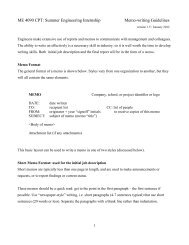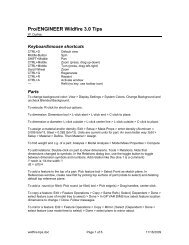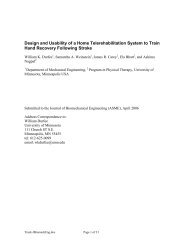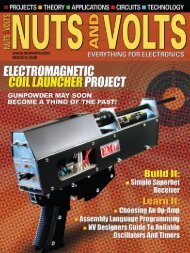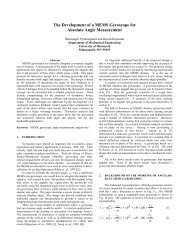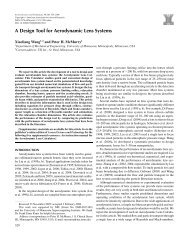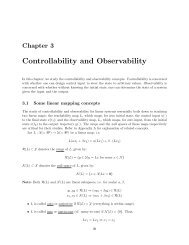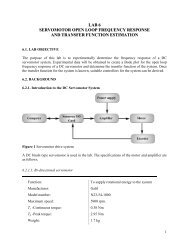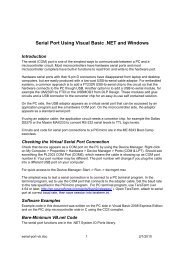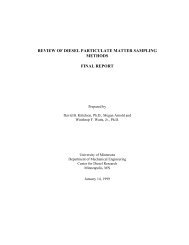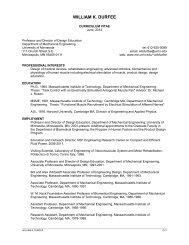Diesel Aerosol Measurement - Department of Mechanical ...
Diesel Aerosol Measurement - Department of Mechanical ...
Diesel Aerosol Measurement - Department of Mechanical ...
Create successful ePaper yourself
Turn your PDF publications into a flip-book with our unique Google optimized e-Paper software.
enter a mobility analyzer section <strong>of</strong> the EAA. The mobility analyzer functions as a lowpass<br />
filter, precipitating particles having high electrical mobility. Varying the applied<br />
voltage within the mobility analyzer allows the electrical mobility pass cut-point to be<br />
varied. The concentrations <strong>of</strong> particles that pass through the mobility analyzer are<br />
determined by measuring the current carried by the charged particles using an<br />
electrometer mounted downstream <strong>of</strong> the mobility analyzer section. Assuming that the<br />
electrical mobility <strong>of</strong> the sampled particles is a monotonic function <strong>of</strong> particle size,<br />
particle size cutpoints can be determined for each electrical mobility delineated by<br />
mobility analyzer voltage. A particle-size distribution can thus be generated by stepping<br />
the mobility analyzer through 11 voltages and measuring the current carried by the<br />
particles with an electrometer. A preclassification stage, such as an impactor or cyclone,<br />
must be used when sampling diesel exhaust in order to prevent the introduction <strong>of</strong><br />
measurement errors from particles larger than 1.0 μm (Yeh, 1993).<br />
The measured particle-size range <strong>of</strong> the EAA is nominally from 3.2 nm to 1.0 μm, but it<br />
is effectively 10 nm to 0.5 μm. The sensitivity <strong>of</strong> the EAA drops <strong>of</strong>f dramatically below<br />
10 nm (Liu and Pui 1974a), due to diffusional particle losses and incomplete particle<br />
charging. The result is that the electrometer current for the first two voltage steps, which<br />
correspond to the 3.2 nm to 5.6 nm and 5.6 nm to 10 nm electrical mobility size ranges,<br />
respectively, contains only random signal noise unless extremely high particle number<br />
concentrations are present in those size intervals.<br />
Approximately 2 to 3 minutes are required for the EAA to cycle through the 11 voltage<br />
steps. The time required for the voltage stepping poses a limit in using the EAA to<br />
measure the size distribution <strong>of</strong> a rapidly varying aerosol. The integral nature <strong>of</strong> EAA<br />
size measurement can also introduce errors if particle number concentrations change<br />
within the time interval <strong>of</strong> a single scan <strong>of</strong> EAA voltages. This has typically precluded<br />
the use <strong>of</strong> the EAA over transient speed and engine load test cycles such as the U.S. EPA<br />
Heavy-Duty Transient Test (40 CFR 86, Subpart N) without some means <strong>of</strong> collecting or<br />
integrating the particles over the cycle prior to analysis by the EAA. Hammerle, et al.<br />
(1994) and Dolan, et al. (1980) used bag samples to collect particles over transient test<br />
cycles for later size analysis by the EAA. Particle losses <strong>of</strong> up to 50% after 20 minutes<br />
were reported by Hammerle et al (1994).<br />
<strong>Diesel</strong> aerosol measurements with the EAA typically necessitate the use <strong>of</strong> relatively high<br />
dilution <strong>of</strong> diesel exhaust samples (300:1 to 1000:1) to prevent electrometer saturation.<br />
Although similar ranges <strong>of</strong> dilution have been reported for roadside dilution <strong>of</strong> vehicle<br />
exhaust, typical laboratory dilution tunnels operate with dilution ratios ranging from<br />
approximately 10:1 to 20:1, necessitating additional dilution <strong>of</strong> the exhaust sample prior<br />
to entering the EAA (Baumgard and Kittelson 1985), (Baumgard and Johnson 1992),<br />
(Bagley, et. al. 1996).<br />
The EAA requires a very steady concentration to produce accurate size distributions. If<br />
concentration shifts during a measurement, the instrument interprets that as an increased<br />
or reduced concentration in the size being measured at the time <strong>of</strong> the transient, even if<br />
the change is due to something occurring in another size range. The EAA has been<br />
6



